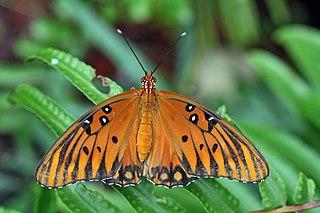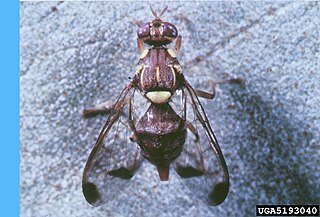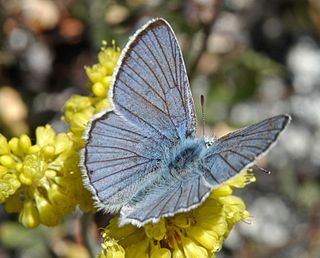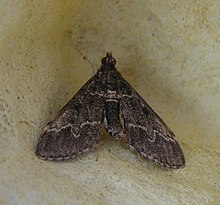
Moths are a paraphyletic group of insects that includes all members of the order Lepidoptera that are not butterflies, with moths making up the vast majority of the order. There are thought to be approximately 160,000 species of moth, many of which have yet to be described. Most species of moth are nocturnal, but there are also crepuscular and diurnal species.

Yucca is a genus of perennial shrubs and trees in the family Asparagaceae, subfamily Agavoideae. Its 40–50 species are notable for their rosettes of evergreen, tough, sword-shaped leaves and large terminal panicles of white or whitish flowers. They are native to the hot and dry (arid) parts of the Americas and the Caribbean.

The Japanese beetle is a species of scarab beetle. The adult measures 15 mm (0.6 in) in length and 10 mm (0.4 in) in width, has iridescent copper-colored elytra and a green thorax and head. It is not very destructive in Japan, where it is controlled by natural predators, but in North America, it is a noted pest of about 300 species of plants including rose bushes, grapes, hops, canna, crape myrtles, birch trees, linden trees, and others.

The Gulf fritillary or passion butterfly is a bright orange butterfly in the subfamily Heliconiinae of the family Nymphalidae. That subfamily was formerly set apart as a separate family, the Heliconiidae. The Heliconiinae are "longwing butterflies", which have long, narrow wings compared to other butterflies. Gulf fritillary is the only member of genus Agraulis.

Bougainvillea is a genus of thorny ornamental vines, bushes, and trees belonging to the four o' clock family, Nyctaginaceae. It is native to eastern South America, found from Brazil, west to Peru, and south to southern Argentina. Different authors accept from 4 to 18 species in the genus. The inflorescence consists of large colourful sepal-like bracts which surround three simple waxy flowers.

The Crambidae are the grass moth family of lepidopterans. They are variable in appearance, the nominal subfamily Crambinae taking up closely folded postures on grass stems where they are inconspicuous, while other subfamilies include brightly coloured and patterned insects which rest in wing-spread attitudes.

Saturniidae, commonly known as saturniids, is a family of Lepidoptera with an estimated 2,300 described species. The family contains some of the largest species of moths in the world. Notable members include the emperor moths, royal moths, and giant silk moths.

Citrus greening disease is a disease of citrus caused by a vector-transmitted pathogen. The causative agents are motile bacteria, Candidatus Liberibacter spp. The disease is vectored and transmitted by the Asian citrus psyllid, Diaphorina citri, and the African citrus psyllid, Trioza erytreae, also known as the two-spotted citrus psyllid. It has also been shown to be graft-transmissible. Three different types of HLB are currently known: The heat-tolerant Asian form, and the heat-sensitive African and American forms. The disease was first described in 1929 and first reported in China in 1943. The African variation was first reported in 1947 in South Africa, where it is still widespread. Eventually, it affected the United States, reaching Florida in 2005. Within three years, it had spread to the majority of citrus farms. The rapid increase in this disease has threatened the citrus industry not only in Florida, but the entire US. As of 2009, 33 countries have reported HLB infection in their citrus crop.

Washingtonia is a genus of palms, native to the southwestern United States and northwest Mexico. Both Washingtonia species are commonly cultivated across the Southern United States, the Middle East, southern Europe, and North Africa, where they have greatly hybridized.

The Pyraloidea are a moth superfamily containing about 16,000 described species worldwide, and probably at least as many more remain to be described. They are generally fairly small moths, and as such, they have been traditionally associated with the paraphyletic Microlepidoptera.

Manduca quinquemaculata, the five-spotted hawkmoth, is a brown and gray hawk moth of the family Sphingidae. The caterpillar, often referred to as the tomato hornworm, can be a major pest in gardens; they get their name from a dark projection on their posterior end and their use of tomatoes as host plants. Tomato hornworms are closely related to the tobacco hornworm Manduca sexta. This confusion arises because caterpillars of both species have similar morphologies and feed on the foliage of various plants from the family Solanaceae, so either species can be found on tobacco or tomato leaves. Because of this, the plant on which the caterpillar is found does not indicate its species.

Antheraea polyphemus, the Polyphemus moth, is a North American member of the family Saturniidae, the giant silk moths. It is a tan-colored moth, with an average wingspan of 15 cm (6 in). The most notable feature of the moth is its large, purplish eyespots on its two hindwings. The eyespots give it its name – from the Greek myth of the cyclops Polyphemus. The species was first described by Pieter Cramer in 1776. The species is widespread in continental North America, with local populations found throughout subarctic Canada and the United States. The caterpillar can eat 86,000 times its weight at emergence in a little less than two months.

The light brown apple moth is a leafroller moth belonging to the lepidopteran family Tortricidae.

Cactoblastis cactorum, the cactus moth, South American cactus moth or nopal moth, is native to Argentina, Paraguay, Uruguay and southern Brazil. It is one of five species in the genus Cactoblastis that inhabit South America, where many parasitoids and pathogens control the expansion of the moths' population. This species has been introduced into many areas outside its natural range, including Australia, the Caribbean, and South Africa. In some locations, it has spread uncontrollably and was consequently classified an invasive species. However, in other places such as Australia, it has gained favor for its role in the biological control of cacti from the genus Opuntia, such as prickly pear.

Lobesia botrana, the European grapevine moth or European grape worm, is a moth of the family Tortricidae.

The melon fly(Bactrocera cucurbitae) is a fruit fly of the family Tephritidae. It is a serious agricultural pest, particularly in Hawaii.

Acleris hastiana is a moth of the family Tortricidae. It is found in Europe, northern Iran, Kazakhstan, Ala Tau, central Siberia, Irkutsk, the Amur region and China. In North America it is found from the north-eastern United States across southern Canada to British Columbia and south along the Pacific Coast to California.

Diflubenzuron is an insecticide of the benzoylurea class. It is used in forest management and on field crops to selectively control insect pests, particularly forest tent caterpillar moths, boll weevils, gypsy moths, and other types of moths. It is a widely used larvicide in India for control of mosquito larvae by public health authorities. Diflubenzuron is approved by the WHO Pesticide Evaluation Scheme.

The blue copper, also known as Lycaena heteronea, is an American butterfly that belongs to the gossamer-winged family. It is bright blue in color. The butterfly is named so because of the bright blue hue of the upper side of the wings of males. Females are brown on their upper side, however both sexes have white colored wings on the underside with black spots. Blue coppers are seen on the western coast of the United States and the Southwest region in Canada, particularly British Columbia and Alberta. The males are often confused with Boisduval’s blue, another species of butterfly. Blue coppers prefer to live in areas where species of Eriogonum are found. Blue copper larvae sometimes form mutualistic associations with Formica francoeuri, an ant species.

The South American palm weevil, Rhynchophorus palmarum, is a species of snout beetle. The adults are relatively large black beetles of approximately one and a half inch in length, and the larvae may grow to two inches in length.





















